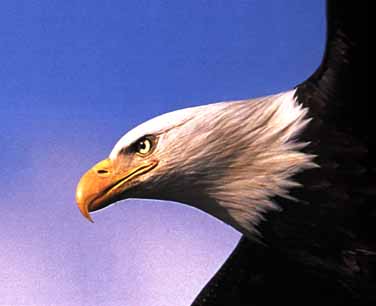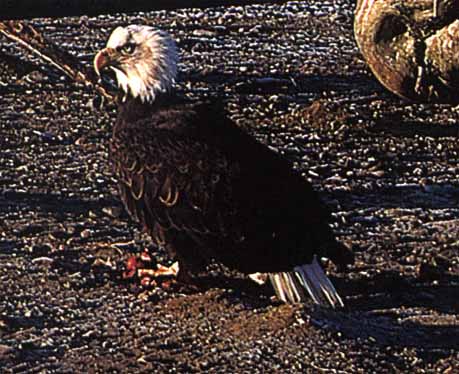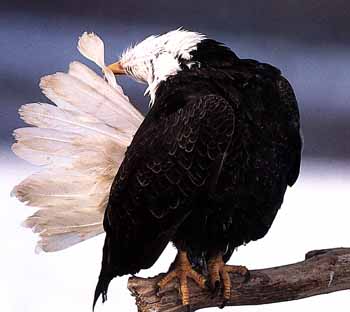

A Nature Conservation Success Story
By Sandra Hartle
But they that wait upon the Lord shall renew their strength; they shall mount up with wings
as Eagles; they shall run, and not be weary; and they shall walk, and not faint. Isaiah 40:31
The Bald Eagle has been on the endangered species list for many years.
The decline in numbers began as early as the 1800's. As man moved westward to hunt, explore and develop settlements the plight of the Bald Eagle began. Man was in competition with the Bald Eagle not only for their habitats, but also their food supply. As early as 1930 the plight of the Bald Eagle was well established. In 1940 the American Bald Eagle Act was passed and the eagle population began to grow again.
|
 |
|
|
|
|
With the invention and use of pesticides a second and more deadly plight began. The eagles food source eating grain and crops protected with pesticides, began to cause more harm to the eagles and their offspring. Poison carried in their prey was passed on to the adult eagle, and then to the eggs they were laying. Over time their eggs became fragile, and most did not hatch. |
By the middle of the 20th Century only a few Bald Eagles existed outside of Alaska
Between 1960 and 1970 most states had declared all eagles and most birds of prey on their protected species lists, and on July 4th 1976 the Fish and Wildlife Service officially listed the Bald Eagles as a national endangered species. This meant they had to consider this bird and its habitat in all of the operations. All of the states began activities to protect the Eagle within their own boarders.
A practice called hacking was started to increase the numbers again. The birds were raised in captivity with no contact being made by man, and released to the wild when they became adult birds.
|
Conservationist are projecting that by the year 2000 more than 250,000 Bald Eagles will inhabit the lower 48 states.
In the North Cascades located in the State of Washington the number of eagles returning to winter here are growing each year. According to reports just a few years ago, few eagles remained in the area. Now as of the Winter of 1998-1999 it was reported that more than 20,000 eagles wintered in just one area of our state. Others can be seen nesting in areas along rivers with high banks that are not accessible by man and his machines. When river rafting on the Green River two years ago many nest could be spotted along the high banks of the river. Some have even chosen a small island in the middle of a Lake Sawyer as a place they can nest, even though the lake is fully developed on three sides. It was the reports of the increased number of returning eagles that sent me out in the cold winter weather to see if I could obtain some good images before a project of this type would be out of the question for me.
|
A close friend had indicated that the nests could easily be seen along the Skagit River during his summer rafting trips, and agreed to take me to the area where he had spotted them. My son, my friend and I all bundled up for this trek as it meant a couple of nights out in the elements. We included in our supplies a hunting blind that we set up along the river in a brushy area. We found an area to camp that would not cause the eagles to become disturbed, and went to the blind before sunrise to wait for the birds to begin feeding.
 |
Many parts of Washington are heavily wooded, with many national parks and forest. This is a very good area for this magnificent bird to spend it's winter, due to our shorter than normal and milder winters.
In order to get the picture above it was necessary to climb up above the eagles and look for a vantage point where we could see the nest from above. This could have been better with the use of a tripod, but that was impossible from where the picture was taken so, I steadied the camera on a tree limb before taking the picture. This one required patience as the birds were below gathering food, and would return often to the nest, but did not get into a good position for photographing them many hours.
 |
The birds were taking advantage of the sunshine, this young looking bird, was fluffed against the cold wind while sitting on the river bank in the sunshine.
 |
After fishing this fellow sat on the root of a stump along the river banks and preened for awhile.
 |
While watching the birds feed and fly this one came in for a catch. I was hoping the next frame on the roll would turn out as he/she snagged the fish from the water but no such luck.
 |
Trout for lunch, after the catch this bird sat on the edge of the river for awhile eating his/her prize.
 |
This bird looked cold and miserable after fishing. It sat here for a very long time, and ice began to form on its feathers.
 |
Yelling at the world, or that is what it seemed like listening to the calls of these birds. I don't know if he/she was aware we were there and was warning the rest or just letting off steam.
 |
This shot was taken as a reminder that these birds can be very dangerous. I would not want to feel that in the back of my head, or anywhere else for that matter.
Later on I was taking another trip, I have made a habit of using the North Cascade Pass to access eastern Washington, my son and I decided to go back to the spot where the eagles had been to see if any were still there. And to our surprise there were still quite a few.
Below are the best pictures taken last year. They may not be the best quality of the group but for my money they are still the best of the lot.
 |
When the male and female birds are sitting next to each other there are some noticeable differences. My son and I returned to the area where we had previously spotted the nest in early May. The two pictured above were sitting in the nest, watching the surrounding area carefully.
My son and I sat and watched them for awhile and then we turned our attention to another nest we had spotted while climbing up to this site, and this is what we saw....
 |
Although this may not be a top notch photo for clarity, I was hand holding the camera with a 600mm lens with a Tameron 2x Teleconverter on it. This is without a doubt the best trophy of both trips.
Although the habits of the eagles have been studied for years, the scientist still do not fully understand the migratory habits. It appears the fledgling birds migrate before the adult birds. Some adults migrate and some remain.
As the numbers of these birds continue to grow the conservation efforts are bearing fruit, and there is now hope that these birds will be here for years to come.
Article and images by Sandra Hartle All rights reserved.
__________________________________________________________
In case you missed
May '99 Feature.. A quick backyard lesson ...Click Here
Mar.99 Feature.. Wildflowers of Texas ...Click Here
Feb.'99 Feature.. Olympic Peninsula, Wa. ... Click Here
Dec'98 feature.. Valley of theEagles .... Click Here Nov.'98 Feature..Garden of the Gods sequel... Click Here Oct.'98 Feature..Garden of the Gods in fall ... Click Here Sept.'98 Feature..Aspen trip with Greyhawk... Click Here
_____________________________________________________________
The images on this site are presented for your personal pleasure. All images appearing on these pages have a copyright with all rights reserved. Many are water marked and/or coded. Re-posting and/or reproduction in any manner, without the express "written" consent of the owner, is strictly prohibited by law. |
____________________________________________________________
Current Feature Main Gallery Contents Home Email
All pages, graphics, created and
maintained by Greyhawk1
_____________________________________________________________________________________
This page hosted by GEOCITIES Get your own Free Homepage